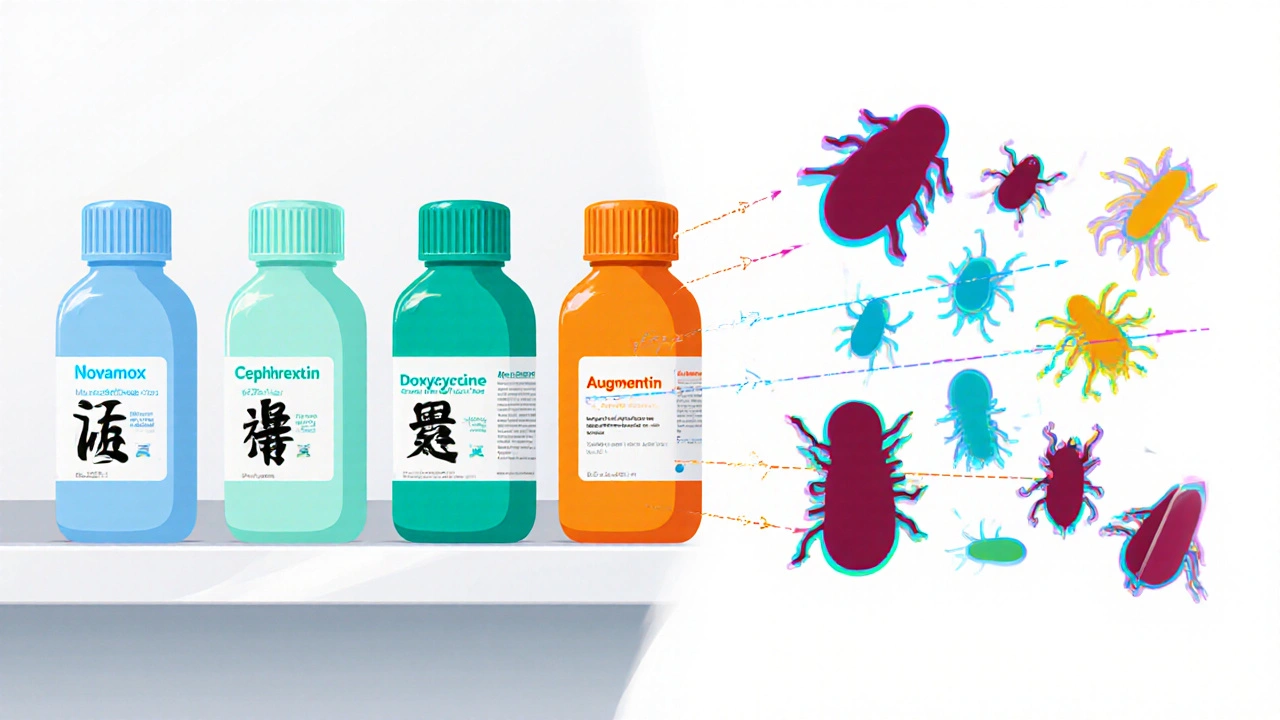When your doctor prescribes an antibiotic, you want to know if there’s a better fit for your infection, budget, or tolerance. Novamox (the brand name for amoxicillin) is one of the most common choices, but dozens of alternatives exist, each with its own strengths and quirks. This guide walks you through the key differences, helping you decide when Novamox is right and when another drug might be smarter.
What Is Novamox (Amoxicillin)?
Novamox is a brand formulation of the generic antibiotic amoxicillin, a member of the penicillin family that targets bacterial cell‑wall synthesis. It’s prized for its broad‑spectrum activity against many Gram‑positive and some Gram‑negative bacteria, its oral availability, and its relatively mild side‑effect profile. Typical adult dosing ranges from 250 mg three times daily for mild infections up to 875 mg twice daily for more serious cases.
How Amoxicillin Works
Amoxicillin belongs to the beta‑lactam class. It binds to penicillin‑binding proteins (PBPs) on the bacterial cell wall, blocking the final steps of peptidoglycan cross‑linking. Without a sturdy wall, bacteria burst under osmotic pressure. This mechanism makes it especially effective against streptococci, Haemophilus influenzae, and many oral anaerobes.
Why Compare Alternatives?
Even a solid antibiotic like Novamox isn’t a one‑size‑fits‑all solution. Some patients develop allergies, others face resistant strains, and cost can vary dramatically across regions. By comparing alternatives, you can:
- Identify a drug with a narrower spectrum to reduce collateral damage to your microbiome.
- Find an option if you’re allergic to penicillins.
- Choose a cheaper or more readily available prescription.
- Match the drug’s pharmacokinetics to the infection site (e.g., lung‑penetrating versus urinary‑tract‑targeted).
Key Criteria for Comparison
Below are the attributes we’ll use to stack Novamox against its rivals:
- Spectrum of activity: Which bacteria are covered?
- Typical dosage and frequency: Convenience matters.
- Side‑effect profile: GI upset, rash, rare severe reactions.
- Allergy considerations: Cross‑reactivity with other beta‑lactams.
- Cost and insurance coverage: Out‑of‑pocket impact.
- Resistance patterns: Local epidemiology data.

Top Alternatives to Novamox
Here’s a quick look at the most frequently substituted antibiotics.
Cephalexin is a first‑generation cephalosporin that shares a beta‑lactam ring but offers a slightly broader Gram‑negative coverage while retaining activity against many Gram‑positive organisms. It’s often chosen for skin infections and uncomplicated urinary tract infections (UTIs).
Azithromycin belongs to the macrolide class, inhibiting bacterial protein synthesis by binding to the 50S ribosomal subunit. It’s a go‑to for atypical pathogens like Mycoplasma and for patients with penicillin allergies. Its long half‑life enables a once‑daily regimen, usually 500 mg on day 1 followed by 250 mg daily for four more days.
Doxycycline is a tetracycline derivative that interferes with the 30S ribosomal subunit, preventing protein translation. It’s especially useful for Lyme disease, acne, and certain intracellular bacteria. Standard adult dosing is 100 mg twice daily, taken with plenty of water to avoid esophageal irritation.
Amoxicillin‑Clavulanate, marketed as Augmentin, combines amoxicillin with clavulanic acid, a beta‑lactamase inhibitor that neutralizes enzymes some bacteria use to resist penicillins. This combo expands coverage to beta‑lactamase‑producing strains like Haemophilus influenzae and many anaerobes.
Side‑By‑Side Comparison
| Brand (Generic) | Spectrum | Typical Adult Dose | Common Side Effects | Allergy Risk | Average Cost (CAD) |
|---|---|---|---|---|---|
| Novamox (Amoxicillin) | Broad‑spectrum (Gram+ & some Gram‑) | 500 mg 3×/day or 875 mg 2×/day | Diarrhea, nausea, rash | Penicillin‑allergy cross‑reactivity | ≈ $12 for 30 caps |
| Keflex (Cephalexin) | Gram+ plus moderate Gram‑ | 500 mg 4×/day | GI upset, mild skin rash | Low cross‑reactivity (~5 %) | ≈ $15 for 30 caps |
| Zithromax (Azithromycin) | Gram+, atypicals, intracellular | 500 mg day 1, then 250 mg d 2‑5 | Abdominal pain, QT prolongation (rare) | Safe for penicillin‑allergic patients | ≈ $25 for 5‑day pack |
| Doryx (Doxycycline) | Broad, including intracellular | 100 mg 2×/day | Photosensitivity, esophagitis | No penicillin cross‑reactivity | ≈ $20 for 20 caps |
| Augmentin (Amoxicillin‑Clavulanate) | Broad + beta‑lactamase‑producing strains | 875 mg + 125 mg 2×/day | Diarrhea, liver enzyme elevation | Same as amoxicillin, plus clavulanate GI upset | ≈ $18 for 30 caps |
Pros and Cons of Each Option
Novamox (Amoxicillin)
- Pros: Well‑studied, inexpensive, easy twice‑or‑three‑daily dosing.
- Cons: Ineffective against beta‑lactamase‑producing organisms; not suitable for penicillin‑allergic patients.
Cephalexin
- Pros: Low cross‑reactivity makes it a safe fallback for mild penicillin allergies; good skin‑infection coverage.
- Cons: Requires four doses per day for optimal efficacy, which can affect adherence.
Azithromycin
- Pros: Once‑daily dosing, short course, safe for most allergies, covers atypical pathogens.
- Cons: Higher cost, potential QT‑prolongation, emerging resistance in streptococci.
Doxycycline
- Pros: Excellent for intracellular bugs, long half‑life, cheap compared to macrolides.
- Cons: Photosensitivity limits outdoor activities, contraindicated in pregnancy and young children.
Amoxicillin‑Clavulanate
- Pros: Broadest coverage among the listed agents; tackles beta‑lactamase producers.
- Cons: More GI upset, slightly higher price, still not safe for severe penicillin allergy.
When to Stick With Novamox
If your infection is caused by a known susceptible organism-like Streptococcus pneumoniae, non‑resistant Haemophilus influenzae, or typical otitis media pathogens-Novamox remains the first‑line choice. Its low cost and simple dosing make it ideal for outpatient treatment where compliance is key. Also, if you’ve already taken a macrolide or doxycycline and experienced side‑effects, reverting to a beta‑lactam can be gentler on the gut.

When to Switch to an Alternative
Consider these scenarios:
- Penicillin allergy: Even a mild rash could make a clinician choose azithromycin or doxycycline.
- Suspected beta‑lactamase‑producing infection: Opt for amoxicillin‑clavulanate or a cephalosporin like cefuroxime.
- Patient needs a short course: Azithromycin’s 5‑day regimen reduces pill burden.
- Cost constraints for a specific brand: Generic doxycycline often undercuts the price of brand‑name macrolides.
- Location‑specific resistance patterns: In regions with high amoxicillin resistance (e.g., certain parts of Asia), clinicians favor doxycycline or a fluoroquinolone, though the latter isn’t covered here due to safety concerns.
Practical Decision Tree
- Is the patient allergic to penicillin?
Yes → Skip Novamox, evaluate azithromycin or doxycycline.
No → Continue. - Is the pathogen known to produce beta‑lactamase?
Yes → Choose amoxicillin‑clavulanate or a cephalosporin.
No → Novamox remains viable. - Do you need a once‑daily regimen?
Yes → Azithromycin or doxycycline (if safe).
No → Dosing flexibility with Novamox or cephalexin. - Is cost a major factor?
Yes → Novamox (generic) or doxycycline are typically cheapest.
No → Consider broader‑spectrum options.
Key Takeaways
- Novamox is an excellent first‑line for many common infections, especially when cost and simplicity matter.
- Cephalexin offers a low‑allergy‑risk alternative for skin and urinary infections.
- Azithromycin shines for atypical pathogens and allergy cases but costs more.
- Doxycycline provides broad, intracellular coverage but isn’t suitable for pregnant patients.
- Amoxicillin‑clavulanate widens the spectrum for beta‑lactamase‑producing bugs at the expense of slightly higher GI side effects.
Frequently Asked Questions
Can I take Novamox and a probiotic together?
Yes. Taking a probiotic a few hours after your antibiotic dose can help maintain gut flora, but it won’t interfere with Novamox’s effectiveness.
What should I do if I develop a rash while on Novamox?
Stop the medication immediately and contact your healthcare provider. A rash can signal a mild allergic reaction; they may switch you to a macrolide or a different beta‑lactam.
Is it safe to take Novamox with alcohol?
Unlike some antibiotics, amoxicillin doesn’t have a known dangerous interaction with alcohol. However, both can irritate the stomach, so moderation is wise.
How long does it take for symptoms to improve on Novamox?
Most patients notice relief within 48‑72 hours. If fever persists beyond three days, follow up with your clinician.
Can I use Novamox for dental infections?
Yes, amoxicillin (Novamox) is commonly prescribed for acute dento‑alveolar infections, often combined with metronidazole for anaerobic coverage.


Albert Fernàndez Chacón
October 18, 2025 AT 14:29I've found that Novamox is a solid first‑line choice when cost matters and the infection is straightforward. Its dosing schedule is easy to stick to, which helps a lot with compliance. For patients without a penicillin allergy, it usually gets the job done without needing a broader‑spectrum drug.
Just keep an eye on any stomach upset and you’ll be fine.
Drew Waggoner
November 9, 2025 AT 19:29Reading this feels like stepping into a pharmacy maze.
Liberty Moneybomb
December 2, 2025 AT 01:29They don't tell you how the pharma giants push Novamox as the default, keeping cheaper generics alive only to line their pockets.
Every time a new study surfaces, the same old narrative repeats, as if the data were being curated behind closed doors.
Meanwhile, patients get shuffled between antibiotics while resistance quietly spreads.
It's a classic case of control through prescription, and we should question who's really benefiting.
Don't be fooled by the glossy charts – there's a hidden agenda at play.
Alex Lineses
December 24, 2025 AT 07:29When you're deciding between Novamox and its alternatives, think about pharmacokinetics and tissue penetration.
Amoxicillin has good oral bioavailability, but for beta‑lactamase‑producing organisms, Augmentin's clavulanate component extends the spectrum.
Cephalexin, on the other hand, offers a slightly better Gram‑negative coverage and lower cross‑reactivity for mild penicillin allergies.
If adherence is a concern, azithromycin’s once‑daily regimen can improve compliance, though watch for QT prolongation.
Always match the drug's MIC data to the suspected pathogen for optimal outcomes.